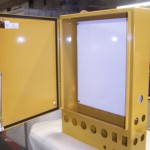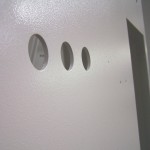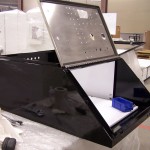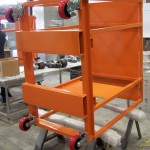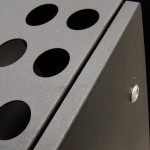-
Recent Posts
- Nema Enclosures Mfg. awarded ISO 9001:2015 re-certification as a Seal of Quality Standard
- NEMA 3RX Rating Now Offered
- NEMA ENCLOSURES MFG. RECEIVES ISO 9001:2015 CERTIFICATION
- Learn about our ATEX & IECEx Ex e Value Added Features and Accessories
- Motor Control Center (MCC) Drop-Over Custom Enclosures
Archives
- May 2021
- February 2021
- July 2018
- October 2017
- September 2017
- April 2017
- January 2017
- December 2016
- March 2016
- February 2016
- October 2015
- August 2015
- July 2015
- May 2015
- October 2014
- August 2014
- June 2014
- April 2014
- March 2014
- February 2014
- September 2013
- August 2013
- July 2013
- June 2013
- May 2013
- April 2013
- February 2013
- January 2013
- December 2012
- November 2012
- October 2012
- September 2012
- March 2012
- February 2012
- August 2011
- May 2011
Powder Coating: Customization and Protection for your Enclosure
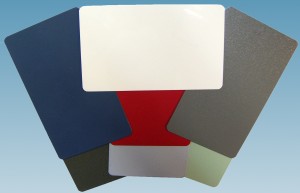 Powder Coating is a free-flowing, dry powder that is applied to metal to provide a high-quality and chemical-resistant finish. When the coating is exposed to heat, the plastic particles melt to form a high-durability film. Nema Enclosures offers in-house powder coating in a wide range of colors, with an excellent color match system, to meet all of your customization needs.
Powder Coating is a free-flowing, dry powder that is applied to metal to provide a high-quality and chemical-resistant finish. When the coating is exposed to heat, the plastic particles melt to form a high-durability film. Nema Enclosures offers in-house powder coating in a wide range of colors, with an excellent color match system, to meet all of your customization needs.
Thermoset powders make up the majority of powders used in industry for a wide variety of decorative and protective applications; this is due to the nature of thermosets versus thermoplastics. Thermosets—once cured and cross-linked—will not melt and flow again if subjected to heat a second time. Thermoplastics, however, will continue to melt and flow repeatedly if exposed to heat.
The basic types of resins used in the formation of thermosetting powders are: epoxy, polyester, and acrylic. Here at Nema Enclosures, we utilize a thermoset TGIC polyester blend to coat our enclosures. TGIC polyester coatings utilize the epoxy functional cross-linker triglycidyl isocyanurate (TGIC) to create a very durable film with excellent weathering.
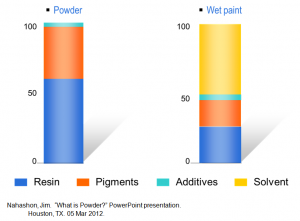 The powder, unlike conventional liquid paint, does not require a solvent to keep the binder and filler parts in a liquid suspension form. Powders can be formulated to meet a wide variety of appearance or performance characteristics; this includes film thickness, gloss, texture, color, and the performance (hardness, chemical resistance, U.V. resistance, etc.) of the coating. Powders are composed of several different components, blended together at high speed to form the final product. Once blended, the mixture is extruded, cooled, and then chipped into pieces. These chips are then ground to a very specific particle size distribution, depending on the application, and screened to ensure larger chips do not pass through.
The powder, unlike conventional liquid paint, does not require a solvent to keep the binder and filler parts in a liquid suspension form. Powders can be formulated to meet a wide variety of appearance or performance characteristics; this includes film thickness, gloss, texture, color, and the performance (hardness, chemical resistance, U.V. resistance, etc.) of the coating. Powders are composed of several different components, blended together at high speed to form the final product. Once blended, the mixture is extruded, cooled, and then chipped into pieces. These chips are then ground to a very specific particle size distribution, depending on the application, and screened to ensure larger chips do not pass through.
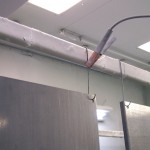 Powder coating is applied over the surface of the metal in a uniform pattern; in order for the particles to adhere to the material, they must first pass through a charging field supplied by the delivery system. The charged particles are then attracted to the grounded metal via a clamp. The powder is attracted to microscopic “ridges” in the grain boundaries, and settles in between these ridges.
Powder coating is applied over the surface of the metal in a uniform pattern; in order for the particles to adhere to the material, they must first pass through a charging field supplied by the delivery system. The charged particles are then attracted to the grounded metal via a clamp. The powder is attracted to microscopic “ridges” in the grain boundaries, and settles in between these ridges.
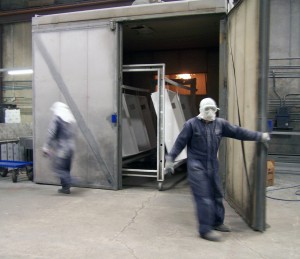 Once the powder has been applied to the enclosure, we place the coated enclosure in our oven and allow it to melt. Once the particles begin to melt, they flow out and chemically react to form a higher molecular weight polymer in a network-like structure. This curing process, called cross-linking, requires a certain degree of temperature and a certain length of time in order to reach full cure and establish the desired film properties the powder was designed for.
Once the powder has been applied to the enclosure, we place the coated enclosure in our oven and allow it to melt. Once the particles begin to melt, they flow out and chemically react to form a higher molecular weight polymer in a network-like structure. This curing process, called cross-linking, requires a certain degree of temperature and a certain length of time in order to reach full cure and establish the desired film properties the powder was designed for.
At Nema Enclosures, we can powder coat stainless steel, carbon steel, and aluminum; however, due to the mechanical properties and grain boundaries of the sheet metal, we do not recommend powder coating for aluminum or stainless steel enclosures. Alternatives for stainless steel include electro-polish or passivation, while an alternative for aluminum is anodizing. Contact our Project Managers at 713-921-2233 for more details on customizing your enclosure.

